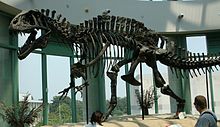| Acrocanthosaurus | |
|---|---|

| |
| Mounted skeleton (NCSM 14345) at the North Carolina Museum of Natural Sciences. | |
| Scientific classification | |
| Domain: | Eukaryota |
| Kingdom: | Animalia |
| Phylum: | Chordata |
| Clade: | Dinosauria |
| Clade: | Saurischia |
| Clade: | Theropoda |
| Family: | †Carcharodontosauridae |
| Genus: | †Acrocanthosaurus Stovall & Langston, 1950 |
| Type species | |
| †Acrocanthosaurus atokensis Stovall & Langston, 1950
| |
| Synonyms | |
| |
Acrocanthosaurus (/ˌækroʊˌkænθəˈsɔːrəs/ AK-roh-KAN-thə-SOR-əs; lit. 'high-spined lizard') is a genus of carcharodontosaurid dinosaur that existed in what is now North America during the Aptian and early Albian stages of the Early Cretaceous, from 113 to 110 million years ago. Like most dinosaur genera, Acrocanthosaurus contains only a single species, A. atokensis. It had a continent-wide range, with fossil remains known from the U.S. states of Oklahoma, Texas, and Wyoming in the west, and Maryland in the east.
Acrocanthosaurus was a bipedal predator. As the name suggests, it is best known for the high neural spines on many of its vertebrae, which most likely supported a ridge of muscle over the animal's neck, back, and hips. Acrocanthosaurus was one of the largest theropods, with the largest known specimen reaching 11–11.5 meters (36–38 ft) in length and weighing approximately 4.4–6.6 metric tons (4.9–7.3 short tons). Large theropod footprints discovered in Texas may have been made by Acrocanthosaurus, although there is no direct association with skeletal remains.
Recent discoveries have elucidated many details of its anatomy, allowing for specialized studies focusing on its brain structure and forelimb function. Acrocanthosaurus was the largest theropod in its ecosystem and likely an apex predator which preyed on sauropods, ornithopods, and ankylosaurs.